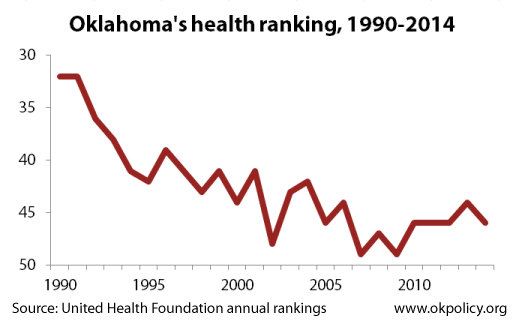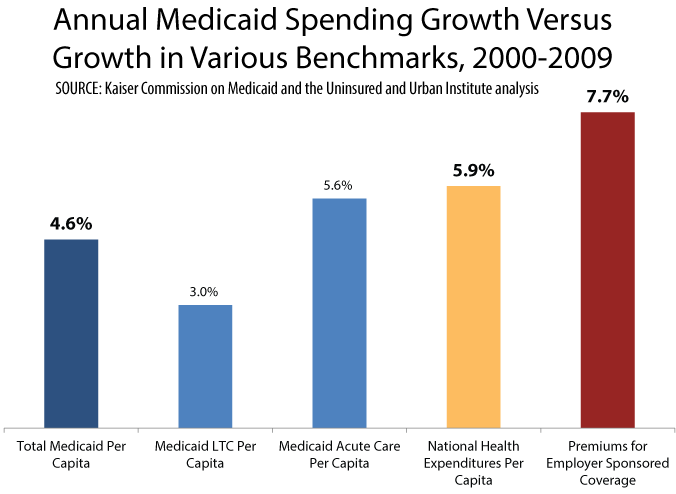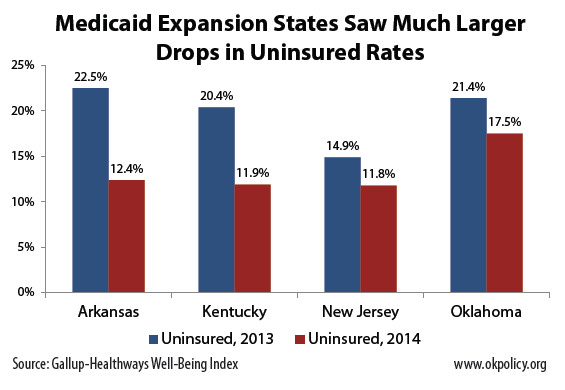Health is decided by far more than the health care one receives. Some estimates argue that health care is responsible for perhaps 10 percent of one’s actual health, with factors such as employment, food insecurity, housing, literacy, and many more all playing a part in determining health outcomes. However, being able to see a doctor does play an important role in health – and in Oklahoma, many people can’t. Without deliberate commitment to fixing this from our state leadership, Oklahoma’s health will continue to fall behind the rest of the nation. Here are eight things you should know about how we got here and what we can do now.
#1: Overall health in Oklahoma has improved recently, though not as quickly as elsewhere

Oklahoma ranks 46th in United Health Foundation’s annual state health rankings, which takes into account everything from cardiovascular deaths to fresh produce consumption to pollution levels. That’s an improvement over previous years, but a steep decline from our ranking in the middle of the pack in the 1990s.
Drug abuse and addiction rates are high, as are child abuse, domestic violence, accidental death, and smoking. Obesity is increasing dramatically. Many of Oklahoma’s poor health outcomes aren’t due to poor individual decisions or individual medical conditions. They are caused by problems that affect entire communities, like stress, limited access to healthy food, lack of transportation, and the inability to get medical help when needed.
Our health and social services shortfalls hit the lower-income population hardest. A higher proportion of Oklahomans are poorer than the American average and access to health insurance is among the worst in the nation.
#2: Health services are an essential focus of government
At the state level we expect government to provide access to physical and mental health care, operate hospitals, promote health and regulate health care, investigate and combat disease outbreaks, and help look after those with disabilities, seniors, veterans, children, and others who cannot meet their basic needs without help.
Health and social services are essential to a healthy community and economy. By most measures, however, the United States falls short of other developed nations and Oklahoma struggles to keep up with the rest of the nation. We have made progress, though. Oklahoma has successfully invested to increase the number of children with health insurance and we have developed a statewide nursing home visitation program.
Taken together, the Health Care Authority, Department of Mental Health and Substance Abuse Services, and the Department of Human Services received roughly one-third of the total dollars appropriated by the state for the current fiscal year. This funding goes to everything from purchasing health care to suicide prevention to child abuse prevention.
#3: Medicaid is a cost-effective health insurance program that especially helps Oklahoma kids

SoonerCare is the program that most people think about first when they think about the state and health. SoonerCare is the state’s Medicaid program, administered by the Oklahoma Health Care Authority (OHCA). This program uses a combination of state and federal dollars to provide coverage to more than 800,000 Oklahomans every month, 2 in 3 of whom are children. As one of the state’s largest insurers, SoonerCare is a significant driver in the economy in Oklahoma. Most working-age adults, however, are excluded from Medicaid in Oklahoma regardless of how little they make. The state has refused to extend coverage to this population under the Affordable Care Act.
Over the past decade, Medicaid costs have risen at a more modest pace than total health expenditures or premiums for employer-sponsored coverage. Per capita costs for Medicaid patients are substantially less than for those covered by private health insurance. Oklahoma’s Medicaid costs are well below the national average.
The agency has faced funding shortages in recent years. OHCA has coped with budget cuts by slashing reimbursements to health care providers and hiking patient copayments to the federal maximum.
#4: Oklahoma provides nearly the lowest funding for mental health treatment in the nation despite high rates of mental illness
The Department of Mental Health and Substance Abuse Services in FY 2017 receiving $325 million in state funding and an additional $100 million from federal and other sources. This agency supports community-based mental health care through contracts with a network of local community mental health centers, alcohol and substance abuse treatment programs, and operates state mental hospitals for adults and youth.
Oklahoma ranks 44th in the nation for mental health spending per capita, even though we have among the highest rates of untreated mental illness. As a result of recent budget cuts to mental health, more than 70,000 Oklahomans had their access to needed counseling reduced, and planned expansions of successful, efficient programs, including mental health and drug courts and suicide prevention, were delayed.
#5: Of the state’s health agencies, the Department of Health has been cut most in recent years

The Oklahoma State Department of Health received approximately $55 million in state appropriations in FY 2017 and approximately $200 million in federal grants, as well as substantial amounts from fees and local property taxes that help operate county health departments. State funding to the Oklahoma Department of Health has been cut by more than one-quarter since 2009.
This agency helps eligible families with family planning, children’s health, child abuse prevention, dental care, and identification of developmental, speech and hearing, and other problems in children. The Department of Health also offers community health services, prevents and controls communicable diseases, and regulates many health care providers.
#6: Oklahoma’s uninsured rate has decreased as a result of the Affordable Care Act – but not nearly as much as it could have

In 2015, Oklahoma had the third-highest uninsured rate in the US (13.9 percent), below only Texas and Alaska. This is in large part due to Oklahoma’s refusal to accept federal funds to expand access to care for low-income adults under the Affordable Care Act (ACA), which leaves more than 100,000 people without access to health coverage. However, about 130,000 Oklahomans got coverage through the new marketplace on Healthcare.gov. Of those who did, more than 8 in 10 received a subsidy to help pay for their coverage. On average, these subsidies reduced their monthly premiums from nearly $400 to under $100.
#7: High uninsured rates are threatening rural hospitals

Our high uninsured rate puts pressure on the health care system as a whole, particularly hospitals. More than half of Oklahoma’s rural hospitals operated at a loss between 2009 and 2013, and several have closed, jeopardizing access to care for whole regions of the state. Last spring, a proposed 25 percent reimbursement cut to Medicaid providers would have forced 4 in 5 hospitals to cut programs like obstetrics because they would be unable to pay for them. It also would have left 9 in 10 nursing homes in the red. High uninsured rates mean that those with health insurance pay more for their coverage, since they’re subsidizing uncompensated care for the uninsured as well.
#8: Oklahoma has proven policy options to improve our health
Last year, Governor Fallin proposed the Medicaid Rebalancing Act of 2020, which would have accepted federal funds to cover the uninsured and increased the tobacco tax to stabilize payments to health care providers. The Rebalancing Act did not get support in the Legislature last year, but the federal dollars are still on the table if Oklahoma chooses to accept them.
On a local level, recent coordinated efforts to decrease the life expectancy gap between zip codes in North Tulsa and South Tulsa show that turning Oklahoma’s dismal health outcomes around is possible. It just takes both recognition of the issue and willingness to provide the resources needed to create real change.






